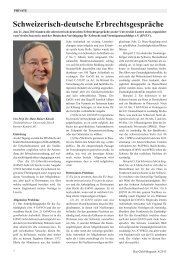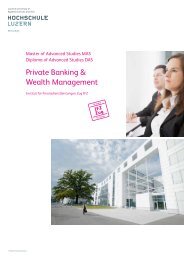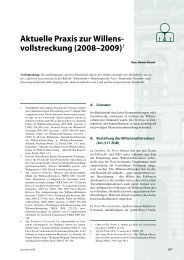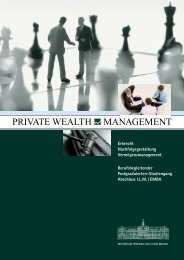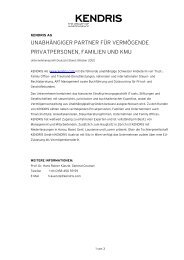Economic Ratios
Economic Ratios
Economic Ratios
- No tags were found...
Create successful ePaper yourself
Turn your PDF publications into a flip-book with our unique Google optimized e-Paper software.
<strong>Ratios</strong>
SHORT AND SWEET<strong>Economic</strong> ratios are an essential management instrument.They create transparency and make possiblea meaningful assessment of a company. Atthe same time, they serve not only as the basis fordecisions and monitoring, but also for guidanceand process optimization.The calculation of economic ratios is in most casesnot standardized. How detailed the economic ratiosystem must be for your company depends not onlyon the implemented accounting standards but alsoon your business goals, the size of your companyand the industry in which you are operating.An economic ratio system tailored specifically toyour company (economic ratio cockpit) allows informationregarding the performance of your companyto be received faster and more condensed and supportsyou in the planning, monitoring and controlof your actions.On the following pages we will provide a generaloverview about the most important economic ratiosused in practice.For additional questions our advisors are gladly atyour disposal.KENDRIS Ltd.
4-5 Financial terms6-7 <strong>Ratios</strong> for listed companies8-9 Cash flow terms and related ratios10-11 Company valuation using WACC12 Capital cost parameters13-15 <strong>Economic</strong> ratios for mid-sized companiesThis brochure can be downloadedon our homepage: www.kendris.com.
4 Financial termsGross profit/gross marginCAPEXcapital expendituresCash flowEBITDAEBITEBTEPSBasic EPSbasic earnings per shareDiluted EPSdiluted earnings per shareDifference between total sales and cost of salesCapital expenditures of a company for long-termfixed assets such as machinery, equipment or realestateNet cash inflow from operating activities duringa period of timeEarnings before interest, taxes, depreciation andamortisationEarnings before interest and taxes (operating result)Earnings before taxesEarnings per shareTotal earnings per share based on the numberof outstanding sharesTotal earnings per share based on the number ofshares issued, adjusted by the effect of all potentiallydiluted ordinary shares (due to the conversionof securities and options)
5Total revenue/salesFree cash flowMarket capitalisationOPEXoperating expensesOrder backlogNOPATWACCweighted average cost of capitalProceeds which accrue to a company in the form ofcash or claims due to the sale of goods or servicesCash flow after current investments but beforedividendsStock exchange value of a company whose sharesare freely tradedAsset consumption which is related to the maintenanceof the operating business activities of acompanyNot yet processed ordersNet operating profit after taxWeighted average cost of capital which is used bymany companies to determine the minimum rate ofreturn for investment projects
6 RATIOS FOR listed COmpaniesProfit marginEBIT marginReturn on salesROSCash flow gradeReturn on equityROEReturn on capitalemployedROCEReturn on assetsROAReturn on net assetsRONAEquity ratioDebt ratioEBIT x 100salesnet profit x 100salescash flow from operating activities x 100salesEBT x 100Ø shareholders’ equityEBIT x 100Ø shareholders’ equity + long term liabilities(net profit + interests on liabilities) x 100Ø total assets(net profit + interests on liabilities) x 100Ø current assets + non-current assets ./. short-term liabilitiesshareholders’ equity x 100total assetsliabilities x 100total assetsGearing net debts x 100liabilities ./. (cash + current receivables)shareholders’ equity
7Interest coverageEarnings per shareEPSEarnings yieldDividend yieldPrice-earnings-ratioPERDividend cover ratioPay-out-ratioBook value per shareMarket capitalizationMarket capitalizationin % of salesMarket capitalizationin % of shareholders’equityinterest expense x 100EBITDAearningsnumber of sharesearnings per share x 100share market pricedividend per share x 100share market priceshare market priceearnings per shareearnings per sharedividend per sharedividend per share x 100earnings per shareshareholders’ equitynumber of sharesnumber of shares x share pricemarket capitalization x 100salesmarket capitalization x 100shareholders’ equity
8 CASH FLOW TERMS AND RELATED RATIOSCash flowdifferentiated presentation1. Direct calculation (based on sales)Liquidity related income./. liquidity related expenses= Cash flow2. Indirect calculation (based on profit)Profit+ non-liquidity related expenses./. non-liquidity related income= Cash flowCash flow fromoperating activitiesCash flow from investingactivitiesFree cash flowEBIT (earnings before interest and taxes)+ depreciation/amortisation/impairment+ creation of provisions./. release of provisions+/./. change in working capital(excluding cash accounts)= Cash flow provided by operating activitiesProceeds from sale of tangible/intangible assetsand from sale of non-current financial assets./. investments in tangible/intangible assets andnon-current financial assets= Cash flow used in investing activitiesCash flow provided by operating activities./. cash flow used in investing activities= Free cash flow
9Cash flow fromfinancing activitiesDebt factorDebt repaymentdurationNet investments inrelation to cash flowOperating cash flowmarginProceeds from capital increases(incl. share premium)+ proceeds from sale of treasury shares./. purchase of treasury shares+ proceeds from new (bank) loans./. repayment of (bank) loans./. distributions to shareholders= Cash flow from financing activitiesnet liabilitiesliabilities ./. (cash + short-term receivables)cash flowliabilities ./. cashcash flownet investments in fixed assets x 100cash flowcash flow provided by operating activities x 100total sales
Was steckt hinter dem WACC?10 COMPANY VALUATION USING WACCThe purchase or sale of a business unit of a companyor an entire company has become a part of the ordinarybusiness in the increasingly globalised marketenvironment. The prerequisite for such transactionsis the assessement, respectively determination ofthe enterprise value. Such value can be determinedwith the help of the discounted cash flow methodusing the Weighted Average Cost of Capital methodto calculate the discount factor. Thus, the operatingcash flows of shareholders and debtholders are discountedwhereby the expected return on investmentof both groups are taken into consideration. Sincethe taxation of equity and liabilities is different, themarket value of liabilities must be subtracted fromthe total enterprise value in order to determine theequity value. A company’s weighted average cost ofcapital is understood to be the interest rate whicha company must pay to its capital providers (debtandequityholders) in order to satisfy their expectedreturn on investment.
11Determination of interest costsThe determination of debt interest is relativelysimple because current credit agreements can beconsidered.It is more difficult to determine equity interest. Asa pragmatic approach the utilisation of a target yieldspecified by the top management should apply becausein this case experience has shown that thereis less discussion about “Why so high?”.With larger companies it is however usual to usethe Capital Asset Pricing Model (CAPM). A marketinterest on risk free investments, e.g. governmentbonds which an investor receives in any case servesthereby as basis. A risk premium is added to thiswhich is oriented towards the degree of operationaland debt risks of the company.Calculation of WACCWACC= E/V * Re + D/V * Rd * (1-Tc)E market value of the firm’s equityD market value of the firm’s debtV Total assets (E + D)Re cost of equityRd cost of debtTc corporate tax rate
12 CAPITAL COST PARAMETERSEquity capital costsBorrowing costsDebt ratioTax rateEquity capital costs are determined from the riskfreebasis interest rate, market risk premium andthe beta factor of the company.For the calculation of the risk-free basis interestrate usually domestic government bonds are used.Increasingly however in recent times data fromyield curves are beeing used.The market risk premium describes the yield demandedby an investor which exeeds the basis interestrate. In Switzerland in the recent past it hasbeen between 4.5% and 5.5% (status 2012).The beta factor expresses the systematic risk(market risk) that the shareholder cannot eliminateby diversification. The beta factor is always determinedin relationship to the entire market.Borrowing costs are determined – like equity capitalcosts – to be calculated from the observable customarymarket conditions on the valuation reference date.In general the view of a potential purchaser and notthe current capital structure of the company shouldbe taken into consideration in the derivation of thecapital structure (market value liabilities/marketvalue equity).The expected marginal tax rate relevant for thecompany at its registered office (if appropriateweighted average rate) is to be used as applicabletax rate.
ECONOMIC RATIOS FOR MID-SIZED COMPANIES 13Cash ratioQuick ratioCurrent ratioWorking capital<strong>Ratios</strong> for liquiditycash and cash equivalentsshort-term liabilities(cash and cash equivalents + net accounts receivables)short-term liabilitiescurrent assetsshort-term liabilitiescurrent assets ./. short-term liabilitiesInvestment quotaDepreciation quotaInvestment intensityAsset elasticity<strong>Ratios</strong> for investingnet investments in fixed assets x 100acquisition costs of fixed assets at beginning of the yeardepreciation on tangible assets x 100book value of tangible assets at year endnon-current assets x 100(Fremdkapital ./. (Flüssige Mittel + kfr. Forderungen))total assetscurrent assets x 100non-current assets
14 ECONOMIC RATIOS FOR MID-SIZED COMPANIESDebt equity ratioSelf-financing ratioAsset protection ratio 1Asset protection ratio 2Asset protection ratio 3Working capital ratio<strong>Ratios</strong> for financingdebt x 100equity(reserves + growth capital) x 100share capitalequity x 100fixed assets(equity and long-term liabilities) x 100fixed assets(equity and long-term liabilities) x 100fixed assets + base stock(current assets ./. short-term liabilities) x 100current assets
15Material costs quotaStaff costs quota<strong>Ratios</strong> for income and expense structurematerial expenses x 100total salespersonnel expenses x 100total salesContribution margin in % contribution margin x 100sales ./. variable coststotal salesDepreciation in %Debt interest in %depreciation x 100total salesinterest expenses x 100total salesCapitalized earningsvalueGross yield<strong>Ratios</strong> for propertyrental income x 100discount raterental income x 100capital expendituresNet yield net rental income x 100rental income ./. property expensesshareholders’ capital invested
KENDRIS Ltd. Mühlemattstrasse 56CH-5001 AarauT +41 (0)58 450 58 00Steinengraben 5CH-4003 BaselT +41 (0)58 450 52 00Avenue Louis-Casaï 86ACH-1216 Cointrin/GenevaT +41 (0)58 450 57 00Av. du Tribunal-Fédéral 34CH-1005 LausanneT +41 (0)58 450 53 00Pilatusstrasse 41CH-6003 LucerneT +41 (0)58 450 55 00Wengistrasse 1CH-8026 ZurichT +41 (0)58 450 50 00The information contained herein is of a general nature and does not refer toany specific circumstances of individual persons or institutions. Althoughwe have tried to make available current information, there is no guaranteethat this completely and correctly reflects the situation at the time ofpublication. The information should therefore not be used as the basisfor specific planning or decisions without obtaining professional advice.Further information: www.kendris.com | © 2013 by KENDRIS



